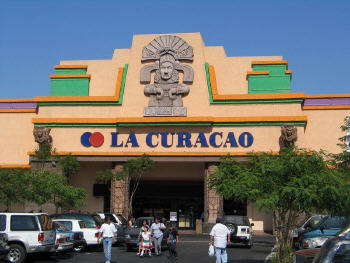Nora Parker (NP): What business challenges facing La Curacao have led you to access Pitney Bowes MapInfo location intelligence solutions?
 |
NP: Are you purchasing tools to use in-house, or accessing services, or some combination thereof? What's driving your decision to access these capabilities in this configuration?
JF: La Curacao uses MapInfo AnySite Online, an Internet-based mapping and site reporting solution. With this resource, La Curacao conducts geodemographic analysis on its customer information, which helps uncover potential new site locations and assess the profitability of future stores.
NP: To what extent are the surrounding demographics important to your site selection work? How do you model new markets like Phoenix and Las Vegas? What are your basic demographic criteria for selecting a retail site? Are they based more on a specific ethnic concentration percentage or a combination of ethnicity, income, education, etc.?
JF: We are finding that our successful stores have approximately 250,000 Hispanics in what we define as the trade area. Since the majority of our sales are on our own credit card, we possess a wealth of customer data that enables us to very narrowly define our customers and their shopping patterns. When we enter new markets, we share our existing store customer data that we have accumulated with Pitney Bowes MapInfo. The retail experts there process the information into a 3-page report entitled Sales Forecast and Demographic Characteristics for La Curacao, which we then use to pinpoint prospective new trade areas for expansion. With over 1,000,000 credit card holders, we have significant data on our customers. As I mentioned previously, it's more than just sheer numbers of Hispanics - income, education and amount of time living in the U.S. are all important factors.
NP: Since you derive a sizable portion of information from store credit cards, how do you spatially reference these data - by address, ZIP Code or other? What information from the credit card purchase is most valuable to you - total store receipt, an analysis of items purchased, or something else?
JF: In our retail stores we also have a travel agency, money transfer, our own ISP and long distance phone company. There are different bits of information that each of these departments pull from our credit card data. All of the information is valuable, but for the most part it is proprietary and the extent to which we use this data to our advantage is very expansive. Pitney Bowes MapInfo provides the tools and expertise to analyze demographics, drive times, trade areas and other key decision variables to evaluate and prioritize new markets for a successful, profitable expansion.
NP: Can you discuss the value that location intelligence software and data have for a small but growing retailer like La Curacao?
JF: Sometimes many smaller businesses think that advanced technology like location intelligence solutions is only for larger chains. However, I think it's critical that smaller, expanding retailers should put more of an emphasis on these types of resources. If you're a 600 store chain and you miss the mark with one of your locations, it's much easier to absorb the pain. For companies such as La Curacao that until recently was only a six store chain, if you open up a lemon it could have dire effects on the company's future. While smaller companies may not be as eager to shell out the costs for this type of technology, it really is well worth it in the long run.
Additionally, turning to a company such as Pitney Bowes MapInfo for detailed customer profile analysis and market screening enables smaller chains to maximize their store spacing. For example, prior to working with Pitney Bowes MapInfo, La Curacao opened a location in the middle of the San Fernando Valley, CA (SFV). Although the store has done very well, it has precluded us from opening additional stores in the SFV. Had we engaged Pitney Bowes MapInfo prior to identifying our existing store we would have realized that, if spaced properly, there would have been room for three SFV locations. The San Gabriel Valley is very similar demographically to the SFV and with the help of Pitney Bowes we are better prepared to maximize our store placement and potentially open three stores in that area.
NP: Tell us more about your business - size, how quickly it's expanding, etc.
JF: With the opening of our Anaheim location in October, we now have 10 locations. We plan to open two additional Arizona locations and two Southern California locations in the coming year. Further expansion plans will include Nevada in 2009 and Texas in 2010. Our stores are 100,000 square feet and our product mix is made up of consumer electronics, furniture, appliances, computers, car stereos, cell phones, video games/consoles, cosmetics, toys and jewelry.